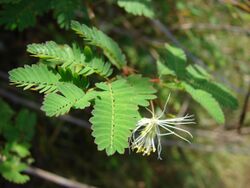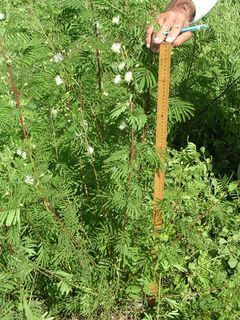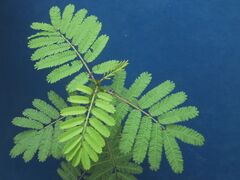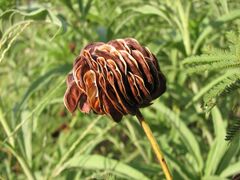Biology:Desmanthus
| Desmanthus | |
|---|---|

| |
| Desmanthus pernambucanus | |
| Scientific classification Error creating thumbnail: Unable to save thumbnail to destination
| |
| Kingdom: | Plantae |
| Clade: | Tracheophytes |
| Clade: | Angiosperms |
| Clade: | Eudicots |
| Clade: | Rosids |
| Order: | Fabales |
| Family: | Fabaceae |
| Subfamily: | Caesalpinioideae |
| Clade: | Mimosoid clade |
| Genus: | Desmanthus Willd.[1] |
| Type species | |
| Desmanthus virgatus (L.) Willd.
| |
| Species | |
|
See text | |
| Synonyms[1] | |
| |
Desmanthus is a genus of flowering plants in the mimosoid clade of the subfamily Caesalpinioideae of the pea family, Fabaceae. The name is derived from the Greek words δεσμός (desmos), meaning "bundle", and ἄνθος (anthos), meaning "flower".[2] It contains about 24 species of herbs and shrubs that are sometimes described as being suffruiticose and have bipinnate leaves. Desmanthus is closely related to Leucaena and in appearance is similar to Neptunia. Like Mimosa and Neptunia, Desmanthus species fold their leaves in the evening. They are native to Mexico and North, Central and South America. Members of the genus are commonly known as bundleflowers.[3] Donkey beans is another common name and originated in Central America, where Desmanthus species are highly regarded as fodder for these domestic draught animals.
Description
| |||||||||||||||||||||
| Phylogenetic tree of Leucaena group[4] |
There are considerable differences in the descriptions of Desmanthus in the literature (see Bogdan 1977; Skerman 1977; National Academy of Science 1979; Allen & Allen 1981; Reid 1983; Hacker 1990). For example, Reid (1983) says that Desmanthus virgatus ranges from "leggy" plants in the humid tropics to compact bushes in the semi-arid zones to prostrate in the montane zones; Allen and Allen (1981) state that Desmanthus grows to 3 metres; Hacker (1990) states that D. virgatus is an erect shrub 1.3 metres tall. All these views illustrate the great diversity and polymorphism within the genus and between species.
Phytochemistry
The root-bark of D. illinoensis, which accounts for half of the total weight of the root system, is reported to contain anywhere from 0 to 0.34% DMT and 0.11% N-Methyltryptamine. Alkaloid content is highly variable in this species.[5]
Likewise, root bark of Desmanthus leptolobus has been found to contain N,N-DMT and related tryptamines. While its only reported quantitative analysis was 0.14% (Appleseed), all instances of co-occurrence with D. illinoensis showed it to be noticeably stronger than D. illinoensis, according to co-thin layer chromatography of the root bark.[6]
Uses
During the 1990s in Australia , three species of Desmanthus were released as pasture legumes and many other accessions are being evaluated as pasture species for clay soils. The three old released cultivars are:
- Desmanthus virgatus Cultivar "Marc"(Accession number: CPI 78373) which is described as early flowering, decumbent to ascending, growing 30 to 60 cm tall and originates from Argentina.
- Desmanthus leptophyllus Cultivar "Bayamo" (CPI 82285), mid season flowering, ascending type, 95–135 cm tall, from Cuba
- Desmanthus pubescens Cultivar "Uman" (CPI 92803), late flowering, decumbent shrub, taller and wider spreading than Marc, 40–100 cm tall, from Mexico.
Of these three, only the cultivar Marc is still commercially available. In 2015 five new cultivars of Desmanthus named JCU 1 to JCU 5 have been granted PBR and are commercially available as a blend named "Progardes", consisting of D. bicornutus, D. leptophyllus and D. virgatus, these have been developed in Queensland Australia as a pasture legume for semi-arid tropical/subtropical alkaline clay soils. Progardes became available in 2013 in Northern Australia and some 35,000 to 50,000 ha has been already sown into native and buffelgrass pasture.[7][8][9] In recent times additional cultivars have seen developed including cv JCU 6,7,8 and 9. These can also be included in the Progardes blend. The breeding of intraspecific and interspecific crosses are well advanced.[10] In terms of animal production Progardes has been to shown to enhance beef production.[11]
In its native range in the United States, the Land Institute is selectively breeding the widely distributed Illinois bundleflower (Desmanthus illinoensis) to be a perennial seed crop for human food, in addition to forage / pasture. It offers many of the advantages in terms of nutrition, protein and nitrogen fixation as soybeans or alfalfa, but as a perennial. Perennial crops tend to require less input of chemicals and energy, and less weed control, for comparable or higher yields to annuals in many systems.[12]
Species
|
|
See also
- Psychedelic plants
References
- ↑ 1.0 1.1 "Genus: Desmanthus Willd.". Germplasm Resources Information Network. United States Department of Agriculture. 2014-01-21. Archived from the original on 2014-10-19. https://web.archive.org/web/20141019082420/http://www.ars-grin.gov/cgi-bin/npgs/html/genus.pl?3526. Retrieved 2014-10-14.
- ↑ Holloway, Joel Ellis; Neill, Amanda (2005). A Dictionary of Common Wildflowers of Texas & the Southern Great Plains. TCU Press. p. 55. ISBN 978-0-87565-309-9. https://books.google.com/books?id=agbm4S1eCQsC.
- ↑ 3.0 3.1 "Desmanthus". Integrated Taxonomic Information System. https://www.itis.gov/servlet/SingleRpt/SingleRpt?search_topic=TSN&search_value=26657. Retrieved 2014-10-14.
- ↑ Hughes, C.E.; Bailey, C.D.; Krosnick, S.; Luckow, M.A. (2003). "Relationships Among Genera of the Informal Dichrostachys and Leucaena Groups (Mimosoideae) Inferred from Nuclear Ribosomal ITS Sequences". in B.B. Klitgaard. Advances in Legume Systematics. Part 10, Higher Level Systematics. Kew Publishing. pp. 221–238. http://biology-web.nmsu.edu/~bailey/Hughes%20et%20al%20Advances%20X.pdf. Retrieved 2014-10-14.
- ↑ Desmanthus (Ayahuasca: alkaloids, plants & analogs)
- ↑ Ayahuasca: alkaloids, plants & analogs: assembled by Keeper of the Trout
- ↑ "New legume capable of persisting in dry times". North Queensland Register. 2013-04-01. http://www.northqueenslandregister.com.au/news/agriculture/general/news/new-legume-capable-of-persisting-in-dry-times/2652519.aspx?storypage=0. Retrieved 2014-10-14.
- ↑ "Australia - Better grass means better beef". Meat Trade Daily News. 2013-04-13. http://www.meattradenewsdaily.co.uk/news/080413/australia___better_grass_means_better_beef_.aspx. Retrieved 2014-10-14.
- ↑ Gardiner, Chris; Nick Kempe; Iaian Hannah; Jim McDonald (2013). "PROGARDES: a legume for tropical/subtropical semi-arid clay". Tropical Grasslands 1: 78–80. doi:10.17138/tgft(1)78-80.
- ↑ Sturat, Peter. "Intraspecific and interspecific crossing of Desmanthus yields new and novel plants". http://www.agronomyaustraliaproceedings.org/images/sampledata/2017/102_ASA2017_Stuart_Peter_Final.pdf.
- ↑ Gardiner, Chris. "Progardes an update". https://researchonlne.hcu.edu.au/59973/.
- ↑ "ILLINOIS BUNDLEFLOWER Desmanthus illinoensis (Michx.) MacMill. ex B.L. Rob. & Fernald". Plant Guide. National Resources Conservation Service. https://www.nrcs.usda.gov/Internet/FSE_PLANTMATERIALS/publications/kspmcpg7714.pdf. Retrieved 2014-10-14.
- ↑
- var. virgatus (L.) Willd.
- ↑ "GRIN Species Records of Desmanthus". Germplasm Resources Information Network. United States Department of Agriculture. http://www.ars-grin.gov/cgi-bin/npgs/html/splist.pl?3526. Retrieved 2014-10-14.
External links
Wikidata ☰ Q3466310 entry
 |







